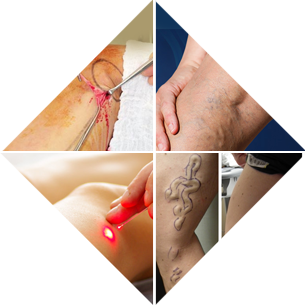
Varicose Vein Removal
What is it?
Varicose veins are twisted, enlarged veins near the surface of
the skin. It gets swollen because of overspill of blood from
veins running deep in the muscles of the legs. This occurs when
the leg veins don't return blood back toward the heart the way
they should. Varicose veins may cause no symptoms. However, most
patients experience problems such as itching, aching and a
feeling of heaviness in the legs. Less frequently, varicose
veins can cause bruising and swelling and can get clotted.
Rarely can they also be the cause of leg ulcers.
The Surgery
Usually, the main feeder vein to the varicose veins is tied off
through two small cuts - one at the groin and one below the knee
- and is then removed. There are many ways of doing the
operation and you can always discuss your surgeon’s method
before the surgery. The most frequently used method is the
passing of a special wire through the cut in the groin into the
vein followed by stripping of the vein. Sometimes another feeder
vein behind the knee has to be tied off as well using a similar
procedure as for the main feeder vein. Following that, smaller
varicose veins are removed through tiny cuts dotted down the
leg. Your operation will either be a day case, where you are
discharged the very same day of the hospitalization, or a
non-day case, where you are in hospital for one or two nights. A
general anaesthetic is given so that you will be unconscious
throughout the operation. Local anaesthetic may be injected into
the groin as well as into the other smaller cuts on your skin to
make them pain free when you wake up.
The first step of the operation is for the ulcers to be
measured. A probe test may be done to check the circulation. A
specimen of the discharge is taken for the laboratory to examine
for the presence of any bugs in the ulcers. This will guide the
antibiotic treatment that you will need in the future. The
ulcers are cleaned. A non-stick dressing is put on the ulcer.
Four layers of special bandages are wrapped round your leg from
the knee down to the base of your toes. The doctors arrange to
see you again each week. You may need to take antibiotics when
they have a report from the laboratory.
Any Alternatives
If left untreated, there is no harm done in the short term. Over
5 or 10 years or more, you will probably notice the veins
getting worse. This is usually associated with worsening of the
symptoms and you will experience more pain, bruising and
swelling. Injection treatment works on its own, if the veins are
only seen below the knee and they are relatively small
Injections are also useful to control small veins that are still
there after an operation. Elastic stockings are helpful if you
are not keen on an operation. They can help determine if your
pains are due to varicose veins. Laser treatment, ointments, and
drug treatment are not helpful for your type of veins.
Camouflage make-up is helpful to cover up small flare veins.
Before the operation
Stop smoking and reduce the weight if you are overweight. (See
Healthy Living). If you know that you have problems with your
blood pressure, heart, or lungs, consult your physician and ask
him to check that these are under control. Check the hospital's
advice about taking the Pill or hormone replacement therapy
(HRT). Check you have a relative or friend who can come with you
to the hospital, take you home, and look after you for the first
week after the operation. Sort out any tablets, medicines,
inhalers that you are using. Keep them in their original boxes
and packets. Bring them to the hospital with you.
On the ward, you may be checked for past illnesses and may have
special tests to make sure that you are well prepared and that
you can have the operation as safely as possible. Please tell
the doctors and nurses of any allergies to tablets, medicines or
dressings. You will have the operation explained to you and will
be asked to fill in an operation consent form. Many hospitals
now run special preadmission clinics, where you visit for an
hour or two, a few weeks or so before the operation for these
checks.

